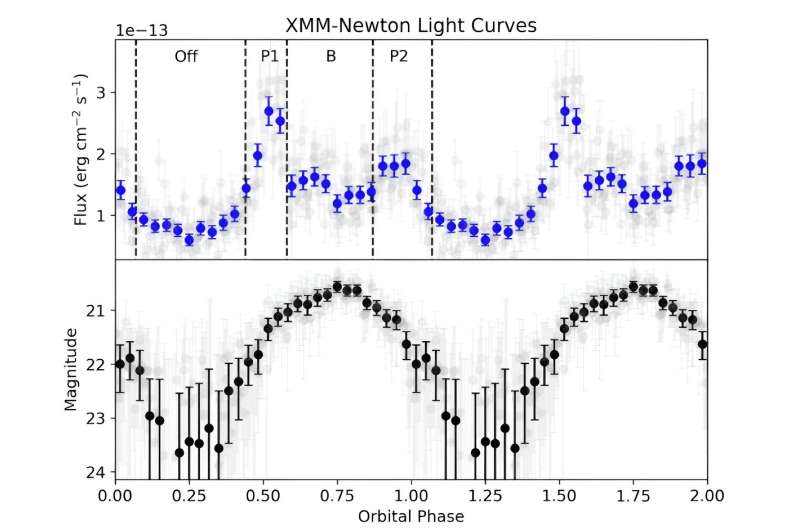June 1, 2024 report
This article has been reviewed according to Science X's editorial process and policies. Editors have highlighted the following attributes while ensuring the content's credibility:
fact-checked
preprint
trusted source
proofread
Study investigates a massive 'spider' pulsar

Astronomers from the Stanford University in California have performed joint X-ray and optical observations of a massive "spider" pulsar designated PSR J2215+5135. Results of the observational campaign, presented in a paper published May 22 on the pre-print server arXiv, provide more hints into the nature of this pulsar.
The most rapidly rotating pulsars, those with rotation periods below 30 milliseconds, are known as millisecond pulsars (MSPs). Researchers assume that they are formed in binary systems when the initially more massive component turns into a neutron star that is then spun up due to accretion of matter from the secondary star.
A class of extreme binary pulsars with semi-degenerate companion stars is dubbed "spider pulsars." These objects are further categorized as "black widows" if the companion has extremely low mass (less than 0.1 solar masses), while if the secondary star is heavier they are called "redbacks."
In spider pulsars, gamma-ray emission and the relativistic particles from the pulsar wind irradiate the companion, consequently driving off a massive stellar wind. Observations show that when the pulsar wind and companion wind collide, they form the so-called intrabinary shock (IBS).
Located some 9,800 light years away, PSR J2215+5135 (or J2215 for short) is a redback spider MSP with a spin period of 2.61 milliseconds and spin-down power of about 50 decillion erg/s. The neutron star in the system has a mass of approximately 2.24 solar masses, while the companion mass is estimated to be about 0.3 solar masses. The orbital period of J2215 is 4.14 hours and its dispersion measure is 225.6 pc/cm3.
Recently, Stanford University's Andrew Sullivan and Roger Romani employed ESA's XMM-Newton spacecraft to take a closer look at J2215. Based on the XMM-Newton data, they produced orbital light curves of J2215 and used them to model the system properties.
The new observations found that the neutron star in J2215 has a mass of approximately 2.15 solar masses and that the companion star loses its mass at a level of 0.0003 Earth masses per year. Therefore, the researchers calculate that J2215 may become an isolated MSP.
Based on the X-ray analysis of J2215, the researchers found that the IBS still wraps around the pulsar. This is typical for redbacks as in such systems, the companion wind dominates the pulsar wind so the IBS wraps around the pulsar, while in black widows the IBS wraps around the companion object.
The study also found that J2215 is located about 10,800 light years away and its spin-down power is at a level of 52 decillion erg/s. The authors of the paper suppose that the IBS of J2215 may reprocess a large fraction of its spin-down power.
More information: Andrew G. Sullivan et al, A Joint X-ray and Optical Study of the Massive Redback Pulsar J2215+5135, arXiv (2024). DOI: 10.48550/arxiv.2405.13889
Journal information: arXiv
© 2024 Science X Network





















